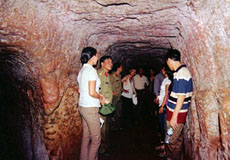The tunnels of Vinh Moc are known having been a legend during the anti-US resistance war for national salvation, a vivid venue to educate patriotism to young generation and a ’must’ for tourists.
 The spectacular tunnel network, also known as an underground village, attests to the endurance, wisdom and bravery of the local people in their fight for national liberation and independence.
The spectacular tunnel network, also known as an underground village, attests to the endurance, wisdom and bravery of the local people in their fight for national liberation and independence.
A foreign tourist once wrote down: “The Vinh Moc Tunnels look like an ancient castle lying quietly under the ground, hiding so many miraculous things about the people who had created them and the epoch when they wereâ€.
With a total length of 2,034m, this underground network is linked with 13 doors (seven opening to the sea and six to the hills). The structure is divided into three layers, the deepest is 22m. They are connected by a 769m long main axis, 1.5m to 1.8m in height and 1.1m to 2m in width.
Along the two sides of the main axis are housing chambers with the capacity of 3-4 people each. There are also three water wells, a large meeting hall with a seating capacity of 50 to 80 people, which was used for meetings, film shows, art performances and even an operation room.
The village also featured unique Hoang Cam stoves which named after the general who invented the stove to allow underground cooking without emitting smoke, thus evading the discovery by the enemy’s bombers.
Deep beneath the dark earth, the people of Vinh Linh, Quang Tri had lived for many years in these narrow tunnels. They survived, and even prospered in their makeshift underground community. During its 2000 days of existence, around 1,200 people lived in the tunnels; as many as 17 children were born inside the tunnels as well. Under the cover of these tunnels, no casualties were reported all though these fierce years of war, highlighting the great value and significance of the Vinh Moc Tunnels, a marvelous story about the land and people here.
Vinh Moc Tunnels were not only the shelter for local people, it also became a place to transport food and ammunitions to Con Co Island (28km off the shore). It was a great distribution of the Vinh Moc Tunnel villagers when Con Co Island still stood firm during the fiercest war. It was commended twice with the Hero titles by the State.
In 1976, the Ministry of Culture and Information (the Ministry of Culture, Sports and Tourism today) recognized the Vinh Moc Tunnels as a national heritage site and included it in a list of especially important historical sites.
Time goes by, the Vinh Moc Tunnels have become both a historical evidence and a tourist destination for those who want to discover a heroic period of Vietnam’s modern history.